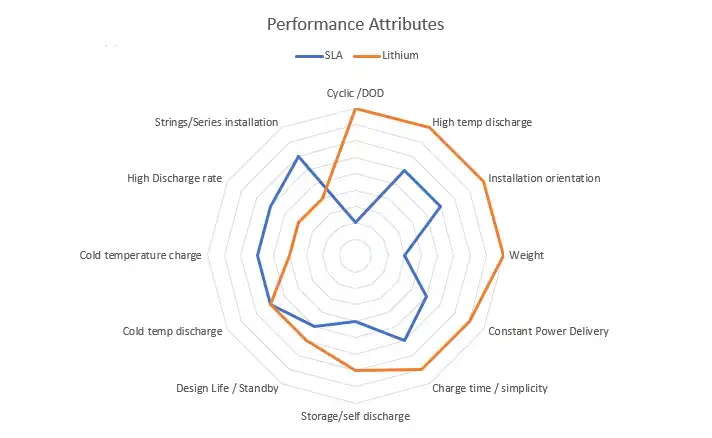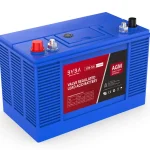Today, most companies operate their vehicles, workplace equipment or renewable energy systems using rechargeable batteries. The most commonly used is the lead acid battery. This mature technology that’s known to be reliable, durable, and can cost effective. However, under the lead acid battery category there are many different types to be aware of. In this article we will talk about the differences between Absorbed Glass Mat (AGM) and Flooded batteries.
Absorbed Glass Mat (AGM) and wet cell or “flooded” batteries are both considered lead batteries and contain an electrolyte solution which causes a chemical reaction and produces electrons. These batteries are recharged when put in contact with a reverse current. But, given the way they are designed, they each have their own pros and cons and these variations should be considered before use.
What is a AGM Battery
Absorbed glass mat batteries or AGM batteries, became popular in the 1980s. They were used to power motorcycles, military, aircraft, and submarines, but now you can find them in everyday cars and trucks.
AGM batteries are a maintenance free alternative to traditional flooded lead-acid batteries. They are designed to provide powerful bursts of starting amps and run electronics for a longer period of time.
WHAT IS AN AGM BATTERY?
You’ve heard the term AGM battery before and may even know that it stands for Absorbent Glass Mat. But, what does Absorbent Glass Mat (AGM) actually mean and how does that enhance the battery’s performance over standard lead acid batteries?
Let’s review some basics of the SLA (sealed lead acid) battery construction. All SLA batteries are comprised of lead plates (positive and negative) and electrolyte that are then arranged into “cells” and placed into a battery case. Some of these batteries are also valve-regulated, which allows for the escape of minor amounts of gas that occurs during the recombination process during charging. Although these batteries allow gases to escape, they are spill-proof batteries (sometimes called valve regulated lead acid or VRLA), and allow for safe operation in almost any position (the only limitation is they are not recommended to be used upside down). Because they are sealed, you don’t need to add electrolyte after the manufacturing process, and any gases that are generated go into a recombination cycle.
AGM BATTERY CONSTRUCTION
In AGM type batteries, the construction follows the same basics as standard SLA, with the addition of a fiberglass mat that is placed between each negative and positive plate to absorb the electrolyte. Since the mat acts like a sponge with the electrolyte, the battery becomes non-spillable.
The AGM battery holds the electrolyte in place and works by allowing the electrolyte to be passed through the fiberglass mat, creating maximum surface area for the electrolyte to touch the plates without it flooding the battery with too much fluid. AGM batteries contain only enough electrolyte to keep the mat wet and if the battery is broken no free liquid is available to leak out. This allows for less electrolyte in the battery while still providing the same energy as traditional SLA batteries.

AGM VS LITHIUM BATTERIES
There are many differences between AGM and lithium batteries. When it comes to choosing the right battery for your application, you need to understand exactly what you are looking to get out of the battery. Is it a deep cycling application, a high rate discharge application or a float standby application? Does the application already have a built in charger for a specific chemistry? What is your budget? etc..

How do AGM batteries work
An AGM (absorbed glass mat) battery contains a special glass mat separator that wicks the electrolyte solution between the battery plates. This material’s design enables the fiberglass to be saturated with electrolyte – and to store the electrolyte in a “dry” or suspended state rather than in free liquid form.
As the battery works, electrolyte is transferred from the glass mat to battery plates as required. The mat contains enough electrolyte for the battery to deliver its full capacity and – should the battery case become damaged or the battery is tipped on its side – its electrolyte will not spill.
What are the Advantages of an AGM Battery?
Due to their unique design, AGM batteries have a lower internal resistance than flooded batteries. This provides them with a number of advantages.
- Higher voltage output – AGM batteries provide more electrical energy than flooded batteries, making it easier to start vehicle engines and providing additional power for technology such as touchscreens, backup cameras and fuel-saving start-stop systems
- Faster recharge rates – AGM batteries recharge up to five times faster than a flooded battery.
- Longer lifespans – How long do AGM batteries last? AGM batteries can last up to two to three times longer than flooded batteries. Their long lifespans can be cost-effective in the long run for consumers.
- Slower discharge rates – An AGM battery holds its charge longer when it’s not being used and is more likely to be recovered if it becomes completely drained.
- Spill-proof – Because the electrolyte is held in place by the plate separators, AGM batteries are spill-proof. This allows you to mount an AGM battery in a variety of positions that aren’t possible with a flooded option.
- Weather resistance – AGM batteries do a much better job of standing up to the negative impact of extreme cold and heat.
- Vibration resistance – AGM batteries are more resistant to vibration, making them ideal for boats and personal watercraft.
Despite their many advantages, AGM batteries, just like other lead-acid batteries, also have their disadvantages. These include:
- High production cost
Unlike the flooded batteries, AGM batteries have a higher production and manufacturing cost. However, they are still cheaper to produce than gel type batteries. Even though the cost of manufacturing these batteries has reduced since their introduction into the market in the 80s, it is still generally higher when compared to other battery types in the market. This, therefore, make them slightly expensive for use in some devices.
- Energy issues
While these AGM batteries have a high-power output, they have a low specific energy. Generally, it is a necessity for batteries that are required to run for a long time under a moderate load to have a high specific load. This means that these batteries cannot be used on several devices.
- Reduced capacity over time
Though AGM batteries keep a charge for a longer time than other batteries, they gradually reduce their charging capacity over time. This is unlike gel batteries that have an advantage in this sector because of their excellent performance dome.
- They are sensitive to overcharging
These AGM batteries, compared to flooded batteries, have a low tolerance to overcharging and high voltages. If they are subjected to these conditions, it shortens their life span.
Can AGM Batteries Be Used for Deep Cycle Applications?
One of the unique things about AGM batteries is their ability to function as both SLI (Starting, Lighting & Ignition) and deep cycle batteries. SLI batteries are the type of battery that’s used to start the engine in your car, truck or RV. They’re built to provide short intense bursts of energy. Deep cycle batteries are engineered to provide smaller, more reliable amounts of power over a longer period of time. You can commonly find deep cycle batteries in applications like golf carts and floor scrubbers. They’re also commonly used as the house battery in RVs and boats.
Are AGM Batteries Good for RVs and Boats?
It’s common for owners of RVs and boats to have two different types of batteries on board, a starting/cranking (SLI) battery to start the engine and a deep cycle battery to power additional applications such as clocks, lights and appliances. Due to their higher voltage output, AGM batteries can serve as dual purpose batteries that do a bit of both. AGM batteries have the strong starting power you need to start your engine, along with enough cycling power to run additional applications. Because of this, many RV and boat owners rely on a single dual purpose battery instead of having both a starting/cranking (SLI) and deep cycle battery on board.
Can You Charge an AGM Battery with a Regular Charger?
One important thing to keep in mind is that you can’t charge an AGM battery using a standard battery charger. This is because AGM batteries have different charging requirements than standard flooded batteries. AGM batteries require a slower, more stable charge than flooded batteries and can’t sustain the high charging speeds used by standard battery chargers.
If you charge an AGM battery with the wrong type of charger, you will end up under or overcharging your battery. Undercharging can cause sulfation on the battery’s plates, reducing its ability to accept a full charge. Overcharging cooks the components inside the battery, which can shorten its lifespan or kill the battery entirely.
When shopping for battery chargers, be sure the model you select is compatible with the chemistry and voltage of the battery you’ll be using it on. For instance, if you have a 12 volt AGM marine battery, you need a charger that works with 12 volt AGM batteries. Many modern chargers come with settings for a number of different battery types.
How Do You Maintain The AGM Battery?
As previously mentioned, the maintenance of AGM batteries is an effortless affair. When not in use, store it in a cool, dry, and well-ventilated place. Do not store it in a discharged state to minimize sulfation. Also, you should avoid overcharging or undercharging it as this causes damage to the electrodes.
Use the correct charger to charge the battery, and it will have your back for more years. The good thing is that the battery is stable and does not need to be upright for it to work.
What Causes AGM Batteries to Fail?
Battery failure is common after it serves you for a specific time. It is a problem if the failure happens during the first five years of use as it is still ‘young’ at this point. Poor maintenance is the leading cause of AGM battery failure. Never overcharge or undercharge it, as it can slash a few service years of this battery.
Using the wrong charger and poor storage also cause these car utilities to fail. Use and maintain the batteries as per the manufacturer’s recommendations.
AGM Batteries Related Products:
Related Products Application:
AGM Batteries Related Posts:
Tag in this article: #AGM Battery
Tips: more detail information, for acid battery






















